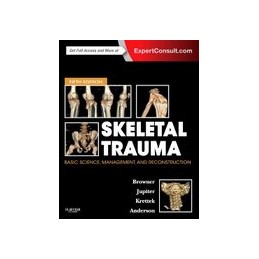- Obniżka


 Dostawa
Dostawa
Wybierz Paczkomat Inpost, Orlen Paczkę, DHL, DPD, Pocztę, email (dla ebooków). Kliknij po więcej
 Płatność
Płatność
Zapłać szybkim przelewem, kartą płatniczą lub za pobraniem. Kliknij po więcej szczegółów
 Zwroty
Zwroty
Jeżeli jesteś konsumentem możesz zwrócić towar w ciągu 14 dni*. Kliknij po więcej szczegółów
Obtain the best outcomes from the latest techniques with help from a whos who of orthopaedic trauma experts. The updated edition of Skeletal Trauma:: Basic Science, Management, and Reconstruction is dedicated to conveying todays most comprehensive information on the basic science, diagnosis, and treatment of acute musculoskeletal injuries and post-traumatic reconstructive problems. Youll be equipped with all of the knowledge needed to manage any type of traumatic injury in adults.
This fifth edition of Skeletal Trauma is an invaluable reference that has been painstakingly prepared to fit the needs of those who treat patients with musculoskeletal trauma...I congratulate the editors and their authors for their unerring success in bringing out the best practices to optimize patient outcomes. This book is an extraordinary accomplishment. Foreword by:: D. C. COVEY, Clinical Professor of Orthopaedic Surgery, University of California
Opis
Forward
Section 1: General Principles
1. The History of Fracture Treatment
2. Global Burden of Musculoskeletal Injuries
3. The Challenges of Orthopedic Trauma in the Developing World
4. Biology and Enhancement of Skeletal Repair
5. Biomechanics of Fractures
6. Closed Fracture Management
6A. Introduction
6B. Basic Principles
6C. Scaphoid Fractures
6D. Distal Radius Fractures
6E. Humeral Shaft Fractures
6F. Proximal Humerus Fractures
6G. Ankle Fracture
6H. Tibial Fractures
6I. Fractures of the Femur
7. Principles and Complications of External Skeletal Fixation
8. Principles of Internal Fixation
9. Evaluation and Treatment of the Multi-Injured Trauma Patient
10. Initial Evaluation of the Spine in Trauma Patients
11. Damage Control Orthopaedic Surgery: A Strategy for the Orthopaedic Care of the Critically Injured Patient
12. Disaster Management
13. Occupational Hazards in the Treatment of Orthopaedic Trauma
13A. Optimal and Safe Use of C-Arm X-Ray Fluoroscopy Units
13B. Prevention of Occupationally Acquired Bloodborne Pathogens
14. Medical Management of the Orthopaedic Trauma Patient
14A. Acute Pain Management, Regional Anesthesia Techniques, and Management of Complex Regional Pain Syndrome
14B. Perioperative Assessment
14C. Management of the Pregnant Woman
14D. Substance Abuse Syndromes: Recognition, Prevention, and Treatment
15. Evaluation and Treatment of Vascular Injuries
16. Compartment Syndromes
17. Open Fractures
18. Soft Tissue Reconstruction
19. Gunshot Wounds and Blast Injuries
20. Pathologic Fractures
21. Osteoporotic Fragility Fractures
22. Surgical Site Infection Prevention
23. Diagnosis and Treatment of Complications
24. Chronic Osteomyelitis
25. Nonunions: Evaluation and Treatment
26. Physical Impairment Ratings for Fractures
27. Outcome Assessment in Orthopaedic Traumatology
28. Professionalism and the Economics of Orthopaedic Trauma Care
29. Psychological, Social, and Functional Manifestations of Orthopaedic Trauma and Traumatic Brain Injury
Section 2: Spine
30. Imaging of Spinal Trauma
31. Pathophysiology and Emergent Treatment of Spinal Cord Injury
32. The Timing of Management of Spinal Cord Injuries
33. Craniocervical Injuries
33A. Occiptal-Cervical Spine Injuries
33B. Atlas Fractures and Atlantoaxial Injuries
33C. C2 Fractures
34. Subaxial Cervical Spine Trauma
35. Thoracolumbar Fractures
35A. Classification
35B. Treatment of Thoracolumbar Burst Fractures
35C. Identification, Classification, Mechanism, and Treatment of Thoracolumbar Fracture-Dislocations
35D. Fractures of the Low Lumbar Fractures
35E. New Concepts in the Management of Thoracolumbar Fractures
36. Fractures in the Anklyosed Spine
37. Osteoporotic Spinal Fractures
38. Avoiding Complications in Spine Trauma Patients
39. Principles of Orthotic Management
Section 3: Pelvis
40. Pelvic Ring Injuries
41. Surgical Treatment of Acetabular Fractures
Section 4: Upper Extremity
42. Fractures and Dislocations of the Hand
43. Fractures and Dislocations of the Carpus
44. Fractures of the Distal Radius
45. Diaphyseal Fractures of the Forearm
46. Trauma to the Adult Elbow and Fractures of the Distal Humerus
46A. Trauma to the Adult Elbow
46B. Fractures of the Distal Humerus
47. Fractures of the Humeral Shaft
48. Proximal Humeral Fractures and Glenohumeral Dislocations
48A. Essential Principles
48B. Proximal Humeral Fractures and Fracture-Dislocations
48C. Glenohumeral Dislocations
48D. Treatment of Fracture Sequelae of the Proximal Humerus
49. Fractures and Dislocations of the Clavicle
50. Scapula and Rib Fractures
50A. Scapula Fractures
50B. Rib Fractures
51. Replantation
Section 5: Lower Extremity
52. Hip Dislocations
53. Medical Management of the Patient with Hip Fracture
54. Intracapsular Hip Fractures
55. Intertrochanteric Hip Fractures
56. Posttraumatic Reconstruction of the Hip Joint
57. Subtrochanteric Fractures of the Femur
58. Femoral Shaft Fractures
59. Fractures of the Distal Femur
60. Patella Fractures and Extensor Mechanism Injuries
61. Knee Dislocations and Soft Tissue Injuries
62. Tibial Plateau Fractures
63. Malunions and Nonunions about the Knee
64. Tibial Shaft Fractures
65. Fractures of the Tibial Pilon
66. Malleolar Fractures and Soft Tissue Injuries of the Ankle
67. Foot Injuries
68. Posttraumatic Reconstruction of the Foot and Ankle
69. Periprosthetic Fractures of the Lower Extremity
70. Principles of Deformity Correction
71. Limb Salvage and Reconstruction
72. Amputations in Trauma
